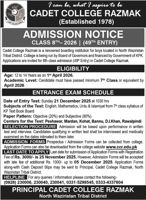BS Disaster Management Admission Process 2026
The admission process begins after the intermediate results are declared. The candidates are advised to fulfill the application forms with the required previous academic records. Universities then display their merit list according to the aggregate. The admission process includes the entry test and interview of the successful candidates.
Admissions in different Institutes for BS Disaster Management
| Date Posted | Last Date | Institute Name | Program Name | Admission Image |
|---|---|---|---|---|
| 26-Nov-2025 | 11-Dec-2025 |
 Government College University Gcu Lahore
Government College University Gcu Lahore
|
|

|
| 03-Aug-2025 | 18-Aug-2025 |
 Bahauddin Zakariya University Bzu Multan
Bahauddin Zakariya University Bzu Multan
|
|

|
| 22-Jul-2025 | 10-Aug-2025 |
 The Karakoram International University Gilgit
The Karakoram International University Gilgit
|
|

|
| 16-Jul-2025 | 31-Jul-2025 |
 Gomal University Dera Ismail Khan (DI Khan)
Gomal University Dera Ismail Khan (DI Khan)
|
|
-16th-July-2025.png)
|
| 02-Jun-2025 | 27-Jun-2025 |
 Lahore University Of Management Sciences Lahore Lums
Lahore University Of Management Sciences Lahore Lums
|
|

|
| 06-Feb-2025 | 12-Feb-2025 |
 Lahore College For Women University (Lcwu) Lahore
Lahore College For Women University (Lcwu) Lahore
|
|

|
| 12-Jan-2024 | 21-Jan-2024 |
 Abdul Wali Khan University Mardan
Abdul Wali Khan University Mardan
|
|

|
-
 Government College University Gcu Lahore Date Posted: 26-Nov-2025 Last Date: 11-Dec-2025 Program: BS Disaster Management
Government College University Gcu Lahore Date Posted: 26-Nov-2025 Last Date: 11-Dec-2025 Program: BS Disaster Management -
 Bahauddin Zakariya University Bzu Multan Date Posted: 03-Aug-2025 Last Date: 18-Aug-2025 Program: BS Disaster Management
Bahauddin Zakariya University Bzu Multan Date Posted: 03-Aug-2025 Last Date: 18-Aug-2025 Program: BS Disaster Management -
 The Karakoram International University Gilgit Date Posted: 22-Jul-2025 Last Date: 10-Aug-2025 Program: BS Disaster Management
The Karakoram International University Gilgit Date Posted: 22-Jul-2025 Last Date: 10-Aug-2025 Program: BS Disaster Management -
 Gomal University Dera Ismail Khan (DI Khan) Date Posted: 16-Jul-2025 Last Date: 31-Jul-2025 Program: BS Disaster Management
Gomal University Dera Ismail Khan (DI Khan) Date Posted: 16-Jul-2025 Last Date: 31-Jul-2025 Program: BS Disaster Management -
 Lahore University Of Management Sciences Lahore Lums Date Posted: 02-Jun-2025 Last Date: 27-Jun-2025 Program: BS Disaster Management
Lahore University Of Management Sciences Lahore Lums Date Posted: 02-Jun-2025 Last Date: 27-Jun-2025 Program: BS Disaster Management -
 Lahore College For Women University (Lcwu) Lahore Date Posted: 06-Feb-2025 Last Date: 12-Feb-2025 Program: BS Disaster Management
Lahore College For Women University (Lcwu) Lahore Date Posted: 06-Feb-2025 Last Date: 12-Feb-2025 Program: BS Disaster Management -
 Abdul Wali Khan University Mardan Date Posted: 12-Jan-2024 Last Date: 21-Jan-2024 Program: BS Disaster Management
Abdul Wali Khan University Mardan Date Posted: 12-Jan-2024 Last Date: 21-Jan-2024 Program: BS Disaster Management
BS Disaster Management University-Wise Admission Comparison in Pakistan 2026
BS Disaster Management is an interdisciplinary degree in Pakistan for students interested in disaster risk reduction, emergency response, climate resilience, and humanitarian assistance . A university-wise comparison helps students understand differences in curriculum focus, field training, and research exposure across institutions. The table highlights faculty expertise, disaster management labs, GIS and hazard mapping facilities, and access to practical training through simulations, drills, and fieldwork. By reviewing admission criteria, merit requirements, program recognition, and fee structures, students can make informed academic decisions. It also shows which universities offer stronger linkages with disaster management authorities, NGOs, and emergency response organizations for internships and field placements. This comparison ensures students select programs aligned with national and international disaster management standards. Overall, it guides students in choosing the best university for pursuing BS Disaster Management in Pakistan.
| University | Duration | Credit Hours | Fee Per Year | Admission Intakes | Eligibility Criteria | Specializations | Scholarship Options | Entry Test |
|---|---|---|---|---|---|---|---|---|
| University of Management & Technology (UMT), Lahore | 4 years | 132 | 180,000 - 300,000 | • Fall (Sep) • Spring (Mar) |
FA/FSc/ICS/I.Com with minimum 50% marks. | • Corporate Risk Management • Resilience Planning |
Merit-based (high achievers), Need-based | UMT Admission Test |
| University of the Punjab (PU), Lahore | 4 years | 130 | 45,000 - 85,000 | • Fall (Aug-Sep) | FA/FSc/ICS/I.Com with minimum 45% marks. | • Disaster Risk Reduction • Humanitarian Response |
Merit scholarships, Punjab Government schemes | PU Entry Test |
| The Islamia University of Bahawalpur | 4 years | 130 | 40,000 - 75,000 | • Fall (Oct-Nov) | FA/FSc/ICS/I.Com with minimum 45% marks. | • Climate & Disaster Management | Punjab & HEC Scholarships, Merit-based | IUB Entry Test |
| Riphah International University, Islamabad | 4 years | 132 | 160,000 - 260,000 | • Fall (Sep) • Spring (Mar) |
FA/FSc/ICS/I.Com with minimum 50% marks. | • Public Health in Disasters | Merit & Need-based, Alumni discounts | University's Admission Test |
| Inspire Institute of Technologies, Rwp | 4 years | 130 | 120,000 - 210,000 | • Fall (Sep) • Spring (Mar) |
FA/FSc/ICS/I.Com with minimum 45% marks. | • Disaster Informatics | Merit scholarships, Skill-based training | Institute's Admission Test |
| University of Engineering & Technology (UET), Lahore | 4 years | 130-136 | 150,000 - 240,000 | • Fall (Oct-Nov) | FSc (Pre-Engineering) with min 60%. | • Engineering in Disaster Mitigation | ECAT Merit, Punjab & HEC Scholarships | ECAT (Punjab) |
| Institute of Professional & Tech. Studies | 4 years | 130 | 100,000 - 190,000 | • Fall (Sep) • Spring (Mar) |
FA/FSc/ICS/I.Com with minimum 45% marks. | • General Disaster Management | Merit-based scholarships | Institute's Own Test |
| Kohat University of Sci. & Tech. (KUST) | 4 years | 130 | 50,000 - 95,000 | • Fall (Sep-Oct) | FA/FSc/ICS/I.Com with minimum 50% marks. | • Disaster Informatics • Climate Adaptation |
Merit scholarships, HEC | KUST Entry Test |
| University of Haripur | 4 years | 130 | 45,000 - 85,000 | • Fall (Sep-Oct) | FA/FSc/ICS/I.Com with minimum 45% marks. | • Environmental Disaster Management | Merit & Need-based, HEC | University Entry Test |
| University of Peshawar | 4 years | 130 | 30,000 - 65,000 | • Fall (Sep-Oct) | FA/FSc/ICS/I.Com with minimum 45% marks. | • Disaster Preparedness & Planning | Merit scholarships, HEC, Provincial quotas | UoP Entry Test |
| Institute of Social Policies & Research, Peshawar | 4 years | 130 | 60,000 - 110,000 | • Fall (Sep-Oct) | FA/FSc/ICS/I.Com with minimum 45% marks. | • Policy & Governance in Disasters | Merit-based, Research grants | Institute's Entry Test |
| NED UET, Karachi | 4 years | 130-136 | 120,000 - 200,000 | • Fall (Aug-Sep) | HSSC (Pre-Engg/Science) with minimum 50% marks. | • Urban Disaster Management | Public University subsidies, Endowment funds | NED University Entrance Test |
| University of Balochistan, Quetta | 4 years | 130 | 30,000 - 65,000 | • Fall (Sep-Oct) | FA/FSc/ICS/I.Com with minimum 45% marks. | • General Disaster Management | Merit-based, HEC, Provincial scholarships | UoB Entry Test |
| Karakoram Int'l University, Gilgit | 4 years | 130 | 40,000 - 80,000 | • Fall (Sep-Oct) | FA/FSc/ICS/I.Com with minimum 45% marks. | • Mountain Disaster Management | Merit-based, HEC, GB scholarships | KIU Entry Test |
| University of Sindh, Jamshoro | 4 years | 130 | 35,000 - 70,000 | • Fall (Sep-Oct) | HSSC with minimum 45% marks. | • Environmental Disaster Management | Merit-based, HEC, Sindh Govt. Scholarships | University of Sindh Entry Test |
| Government College University (GCU), Lahore | 4 years | 130 | 55,000 - 100,000 | • Fall (Sep-Oct) | FA/FSc/ICS/I.Com with minimum 50% marks. | • General Disaster Management | Merit & Need-based, Punjab scholarships | GCU Entry Test |
| Bahauddin Zakariya Univ., Multan | 4 years | 130 | 35,000 - 70,000 | • Fall (Sep-Oct) | FA/FSc/ICS/I.Com with minimum 45% marks. | • General Disaster Management | Merit-based, HEC, BZU scholarships | BZU Entry Test |
| Gomal University, D.I. Khan | 4 years | 130 | 40,000 - 75,000 | • Fall (Sep-Oct) | FA/FSc/ICS/I.Com with minimum 45% marks. | • General Disaster Management | Merit-based, HEC, Provincial scholarships | Gomal University Entry Test |
| Abdul Wali Khan Univ., Mardan | 4 years | 130 | 30,000 - 65,000 | • Fall (Sep-Oct) | FA/FSc/ICS/I.Com with minimum 45% marks. | • General Disaster Management | Merit scholarships, Need-based | University Entry Test |
| University of the Poonch, Rawalakot | 4 years | 130 | 35,000 - 70,000 | • Fall (Sep-Oct) | FA/FSc/ICS/I.Com with minimum 45% marks. | • General Disaster Management | Merit-based, HEC, AJK Govt. Scholarships | UPR Entry Test |
| GCU Lahore — Kala Shah Kaku Campus | 4 years | 130 | 50,000 - 90,000 | • Fall (Sep-Oct) | FA/FSc/ICS/I.Com with minimum 50% marks. | • General Disaster Management | Merit & Need-based, Punjab scholarships | GCU Entry Test |
| Lahore College for Women University | 4 years | 130 | 40,000 - 80,000 | • Fall (Aug-Sep) | FA/FSc/ICS/I.Com with minimum 45% marks. (Female only) | • Community-Based Disaster Mgmt. | Merit scholarships, Punjab schemes | LCWU Entry Test |
| Ghazi University, D.G. Khan | 4 years | 130 | 35,000 - 70,000 | • Fall (Sep-Oct) | FA/FSc/ICS/I.Com with minimum 45% marks. | • General Disaster Management | Merit-based, HEC, Punjab scholarships | Ghazi University Test |
| Preston University (DRI) | 4 years | 130 | 120,000 - 220,000 | • Fall (Sep) • Spring (Mar) |
FA/FSc/ICS/I.Com with minimum 45% marks. | • Disaster Research & Mitigation | Merit-based scholarships | University Admission Test |
Eligibility Criteria
The candidate must have an intermediate or equivalent with a minimum of 50% marks.
Admission Intake
In a given year, there are two rounds of admissions. The first round consists of yearly admissions, whilst the second round consists of admissions twice a year.
Entry Test
Each university has its own set of admission standards. There are various sorts of admittance tests for postgraduate admissions:
National Testing Service (NTS): NTS is a National Testing Service that is necessary for entrance to bachelor's programmes. The test is divided into several sections, including analytical assessment, logical reasoning, and general knowledge. The test is divided into sections based on the type of degree.
University Test : MCAT/NTS examinations are accepted by the majority of universities. Students who have not taken any of the graduate tests are then needed to take the specific university test. The exam often includes logical, analytical, and field-related questions. Some universities exclusively consider their admissions test, but others allow a general assessment test.
Merit Lists
After the admission process is completed, every university displays its merit list. The merit is based on the previous academic records, entry test, and the interview (if any) given at the time of admission. There can be various merit lists according to the seat availability of the public and private sector universities.
Fee Structure
The fee structure differs for several universities. The private sector has a relatively higher fee structure than the public sector which is divided in a quarterly manner at most universities.
Institutions
Some HEC recognized universities offering BS in disaster Management are:
- University Of Punjab
- University of Management and Technology, Lahore
- The Islamia University Of Bahawalpur
- Kohat University Of Science & Technology
- University Of Balochistan
Public Sector
- University Of Punjab
- The Islamia University Of Bahawalpur
- Kohat University Of Science & Technology
- University Of Balochistan
Private Sector
- University of Management and Technology, Lahore








